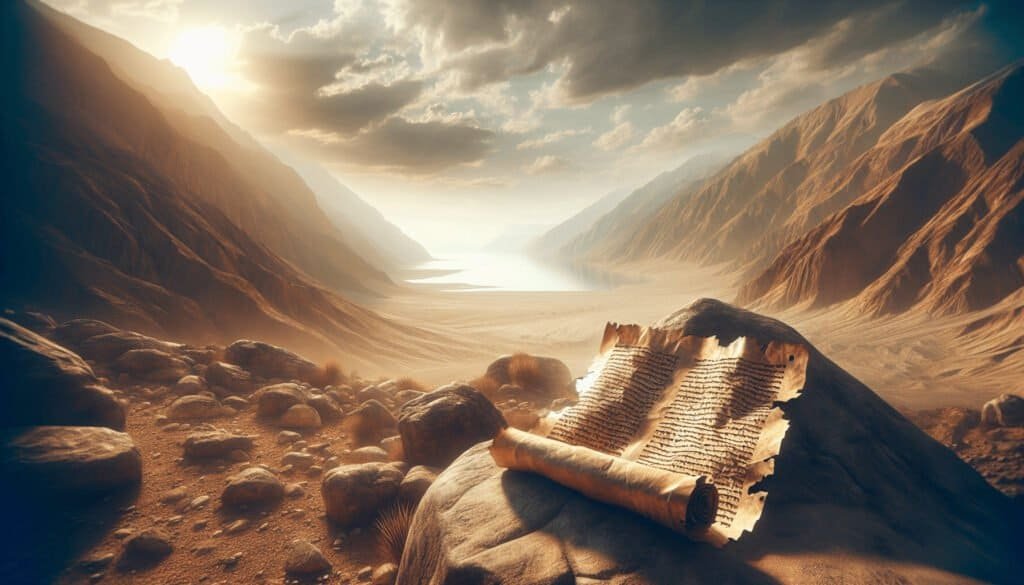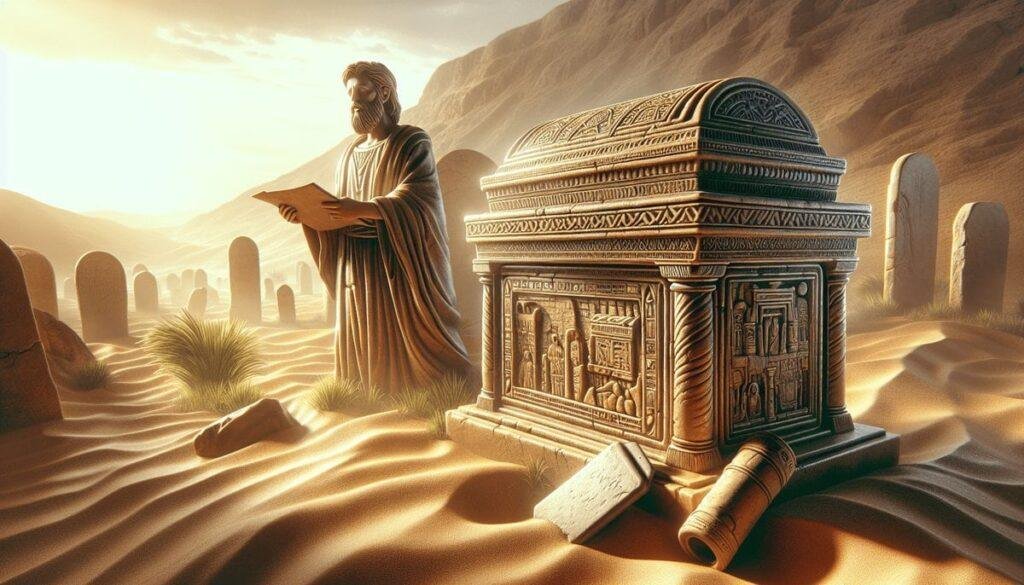Isn’t it intriguing how centuries-old secrets can still pique our curiosity? The kind of treasure you’d expect in a gripping novel rather than reality—yet such is the case with the Dead Sea Scrolls and their enigmatic origins near Qumran. Let’s stroll through this fascinating story together, unraveling the mysteries held within dusty manuscripts and desolate landscapes.
The Discovery of the Dead Sea Scrolls: A Historical Treasure
Imagine wandering through the arid landscapes of the Judean Desert, only to stumble upon a shepherd boy tossing stones into a cave. This very scenario unfolded in 1947, when a young Bedouin accidentally discovered the first of the Dead Sea Scrolls in a cave near Qumran. What began as a mundane day soon escalated into one of the most significant archaeological finds of the 20th century.
Unearthing Ancient Texts
These scrolls, discovered in a series of 11 caves, comprise a collection of over 900 texts. They include biblical manuscripts, sectarian writings, and other documents reflecting the early Jewish culture and beliefs. The astonishing preservation of these materials, some written as far back as the third century BCE, offers a rare glimpse into the lives of those who lived in and around Qumran.
The Importance of the Dead Sea Scrolls
You may wonder—why do these scrolls matter? They hold immense significance for several reasons:
- Biblical Textual Studies: The scrolls provide scholars with some of the oldest known copies of biblical texts, allowing for critical comparisons with later versions of the Hebrew Bible.
- Cultural Insights: They reveal the beliefs, practices, and social dynamics of a Jewish group that existed during the Second Temple period.
- Historical Context: The scrolls help contextualize emerging Christianity and its interactions with contemporary Jewish thought.
The Enigmatic Qumran Community
Stepping back from the manuscripts, let’s take a look at the mysterious community that inhabited Qumran. For centuries, scholars have debated the identity of these ancient people. Were they Essenes, a sect of Judaism known for their ascetic lifestyles? Or perhaps they were another group entirely?
Life in Qumran
Life in Qumran would have been quite different from what you might experience today. Picture a community nestled along the western shore of the Dead Sea, with rigorous routines centered around ritual purity, communal living, and scriptural study.
- Daily Taxes: It’s said that these individuals practiced strict economic measures to support their community, including shared resources to ensure everyone was provided for.
- Ritual Purity: Ritual baths, known as mikvahs, were essential for the community, which held cleanliness in high regard. You would find them engaging in daily purification rituals that highlighted their commitment to spiritual discipline.
The Secular vs. Sacred Debate
The relationship between secular living and the sacred texts has long fascinated scholars. While some argue that the Qumranites distanced themselves from broader Jewish society to ensure their own tradition’s survival, others suggest that they were actively engaged with the cultural milieu of their times.

The Scrolls: A Closer Look
Now that you have a taste of the broader context, let’s peek at the scrolls themselves. What do they say, and how do they relate to your understanding of ancient scripture?
The Biblical Manuscripts
Among these ancient works, several notable biblical texts have emerged. You might particularly enjoy the insights gleaned from:
- Isaiah Scroll: This well-preserved text presents a nearly complete version of the book of Isaiah, offering a fascinating snapshot of biblical transmission.
- Psalms Scroll: You’ll find different versions of psalms that underline a diverse tradition of worship that varied even within Judaism.
Sectarian Texts: The Community Rule
In addition to biblical texts, the scrolls include specific writings that delineate the rules and regulations governing the Qumran community, often referred to as the “Community Rule.” If you were to read it, you’d uncover:
- Ritual Practices: Insights into daily life and shared beliefs illustrate the importance of purity and community cohesion.
- Apocalyptic Visions: Some texts speak of eschatological expectations, revealing how these ancient people viewed time and divine intervention within their world.
Historical Texts
Beyond religious texts, the Dead Sea Scrolls also contain historical accounts that allow you to appreciate the political and religious turbulence of the era. The War Scroll, for instance, portrays a cosmic battle between the “Sons of Light” and the “Sons of Darkness,” reflecting the apocalyptic expectations prevalent at the time.
The Qumran Passage: Secrets Untold
As we tread along this journey through Qumran, let’s shine a light on what’s been termed the uncharted Qumran Passage. The intrigue comes not just from the already known—after all, every nook and cranny harbors a whispered secret.
Archaeological Significance
Could there be undiscovered elements waiting to be revealed? While much has been unearthed, many areas surrounding Qumran remain unexplored. Archaeologists continue to seek additional evidence that could paint a more comprehensive picture of this fascinating community.
The Role of Modern Technology
You might be curious about how technology is influencing the quest to unearth more about Qumran. Innovative imaging techniques and analysis tools are aiding researchers in uncovering intricate details from the scrolls and even enabling them to read texts that are too fragile for handling.
- Hyperspectral Imaging allows the scholar to distinguish between ancient ink and parchment, revealing hidden texts that could rewrite historical narratives.
- Radiocarbon Dating offers a scientific approach to dating perpetual finds, thereby anchoring events in a more precise timeline.

The Qumran Community and the Watchman’s Duties
As we draw nearer to the intricate specifics of life in Qumran, you might find yourself fascinated by the roles assumed within this secluded community. Among these roles, that of the watchman stands out in many texts and passing echoes.
The Watchman’s Role
What does it mean to be a ‘watchman’ in this context? In ancient Qumran, the watchman embodies the idea of vigilance—alertness to both physical and spiritual dangers.
- Guardians of the Community: Just as a modern-day sentry ensures safety, the Qumran watchmen likely fulfilled similar responsibilities by safeguarding their treasured texts and community members.
- Spiritual Vigilance: Watchmen weren’t just on guard against external threats; they were also keepers of spiritual integrity, ensuring that all adherents adhered to the community’s strict guidelines.
Moonlit Duties
The phrase moonlit duties evokes a sense of mystery and intrigue. Imagine these watchmen emerging at night, illuminated by silver moonlight as they patrol the fringe of the community. The quiet of the desert night could amplify their sense of purpose.
- Night Watch: The tranquil eeriness of the landscape would allow the community’s guardians to remain vigilant, ensuring that rogue elements or intruders were kept at bay.
- Rituals Under the Stars: There could even have been moments where watchmen would partake in ceremonial activities, invoking a sense of unity and shared purpose under the celestial expanse.
Theological Significance of the Scrolls
Now that we’ve traversed through the practical realities of Qumran life, let’s turn our gaze towards the deep theological implications of the Dead Sea Scrolls. As conversations about faith continue to evolve today, understanding these ancient texts helps define the contours of belief.
Messianic Expectations
Within the scrolls, concepts of messianic prophecy take center stage. These texts convey how the community understood the anticipated arrival of a Messiah, possibly even providing insight into views contemporary to Jesus’ life.
- Diverse Messianic Figures: You might notice that the scrolls reference multiple messengers. In contrast to the singular messianic figure present in Christianity, these texts suggest a multiplicity that could include priests, prophets, and warrior-like figures.
- Eschatological Themes: Another theme worth pondering is their expectation of transformative divine intervention, shedding light on how early Jewish communities shaped their worldviews.
Impact on Modern Judaism and Christianity
The discovery of the Dead Sea Scrolls has influenced both academic circles and lay believers alike. As you ponder their implications, consider how these ancient writings resonate today.
- Contextual Understanding: For Jews and Christians, understanding these texts bridges historical gaps. There’s a unifying force found in shared roots, reflected in the sacred traditions we participate in today.
- Dialogue between Faiths: The texts have fostered discussions about the continuity and divergence of faith practices, revealing how much influences shape religious experience tremendously.
The Qumran Legacy Today
With the historical, cultural, and theological elements laid bare, let’s contemplate the legacy of the Qumran community and the Dead Sea Scrolls. How do these ancient elements resonate in your life today?
The Search for Meaning
As you walk through the remnants of the Qumran community and gaze upon the scrolls, think about the relentless quest for meaning that molds not just ancient cultures, but also impacts your personal journey. What echoes from the past challenge or inspire you?
- Wisdom of Ancients: These scrolls resonate as voices of the past offering timeless reflections about morality, spirituality, and human nature.
- Personal Reflection: You may find lessons in their rituals and commitments, perhaps prompting you to examine your own sacred practices and community life.
The Qumran Passage: Continuing the Journey
While the Dead Sea Scrolls have redefined much about our understanding of biblical history, the journey of discovery does not end here. Modern scholars, through continued archaeology and technology, are bound to reveal even more insights into this elusive chapter of history.
- Future Findings: With every archeological dig, the mysteries of Qumran may be further explored. Every new fragment or relic recovered could shift understandings and narratives profoundly.
- Inspire Curiosity: New discoveries have the potential to inspire curiosity within communities worldwide, sparking dialogue about historical contexts and their meanings in contemporary life.
Conclusion: Unlocking the Mysteries
The arcane tapestry of the Dead Sea Scrolls continues to unravel through our collective exploration and understanding. The Qumran community, with all its mysteries and rituals, offers a rich context worth pondering.
By immersing ourselves in the intriguing narratives represented by the scrolls, you engage not only with history but also with your understanding of spirituality and community.
If layers of meaning await discovery, isn’t it thrilling to think about who you might become in the light of this wisdom? The journey through the uncharted Qumran Passage has only sparked the beginning of endless questions—and perhaps, answers—waiting just around the corner.


